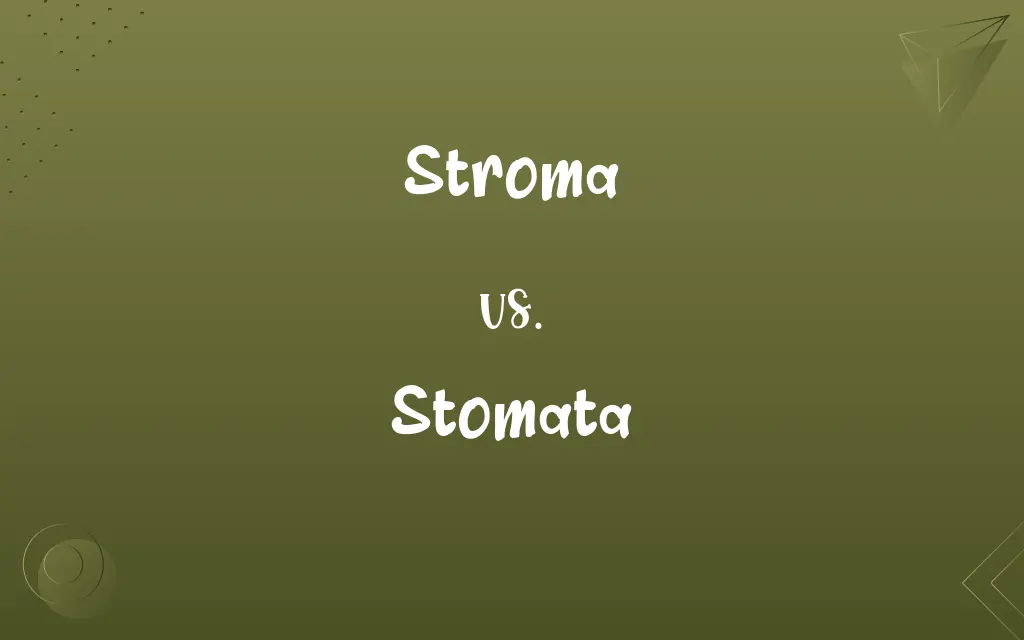Stroma vs. Stomata: Know the Difference

By Shumaila Saeed || Published on January 26, 2024
Stroma is the supportive tissue of an organ, while stomata are microscopic openings on plant leaves for gas exchange.

Key Differences
Stroma refers to the supportive framework of an organ, consisting of connective tissue and blood vessels. In contrast, stomata are small openings or pores found primarily on the underside of plant leaves, playing a crucial role in gas exchange.
Shumaila Saeed
Jan 26, 2024
In the context of a plant's leaf, the stroma is found within the chloroplasts, serving as the site of the light-independent reactions of photosynthesis. Stomata, on the other hand, facilitate the exchange of gases like oxygen and carbon dioxide between the plant and its environment.
Shumaila Saeed
Jan 26, 2024
The stroma in human or animal tissues provides structural support and is often involved in immune responses. Meanwhile, stomata regulate water loss through transpiration and are essential for maintaining the plant's water balance.
Shumaila Saeed
Jan 26, 2024
Stroma can be found in various organs, including the ovaries, lymph nodes, and the eye's cornea, where it provides both structural and functional support. In contrast, stomata are specific to plants and are integral to the process of photosynthesis by allowing carbon dioxide to enter the leaf.
Shumaila Saeed
Jan 26, 2024
The density and distribution of stroma vary depending on the organ and its function. Conversely, the distribution and density of stomata on a leaf surface are influenced by environmental factors like light, humidity, and temperature.
Shumaila Saeed
Jan 26, 2024
ADVERTISEMENT
Comparison Chart
Location
Found in various organs, including eyes, ovaries
Primarily on the underside of plant leaves
Shumaila Saeed
Jan 26, 2024
Function
Provides structural support, involved in immune responses
Facilitates gas exchange and transpiration
Shumaila Saeed
Jan 26, 2024
Role in Photosynthesis
Part of chloroplasts, site of light-independent reactions
Enables the entry of CO2 necessary for photosynthesis
Shumaila Saeed
Jan 26, 2024
ADVERTISEMENT
Stroma and Stomata Definitions
Stroma
Stroma is the supportive tissue in organs.
The stroma in the cornea helps maintain its shape and transparency.
Shumaila Saeed
Jan 11, 2024
Stomata
Stomata are microscopic openings on plant leaves.
The stomata opened to allow gas exchange during the day.
Shumaila Saeed
Jan 11, 2024
Stroma
In chloroplasts, stroma is the site of the Calvin cycle.
The stroma within the chloroplasts contains enzymes vital for photosynthesis.
Shumaila Saeed
Jan 11, 2024
Stomata
Stomata facilitate the entry of carbon dioxide for photosynthesis.
Carbon dioxide entered the leaf through the stomata.
Shumaila Saeed
Jan 11, 2024
Stroma
Stroma plays a role in immune responses in lymphoid organs.
The stroma in lymph nodes is crucial for mounting an immune response.
Shumaila Saeed
Jan 11, 2024
ADVERTISEMENT
Stomata
Stomata regulate the plant's water loss.
The plant's stomata closed to conserve water in dry conditions.
Shumaila Saeed
Jan 11, 2024
Stroma
The connective tissue framework of an organ, gland, or other structure, as distinguished from the tissues performing the special function of the organ or part.
Shumaila Saeed
Jan 10, 2024
Stomata
Stomata are found primarily on the underside of leaves.
Observing the leaf under a microscope, she counted the number of stomata.
Shumaila Saeed
Jan 11, 2024
Stomata
Stomata are influenced by environmental factors.
The stomata density varied with the plant's exposure to light.
Shumaila Saeed
Jan 11, 2024
Stroma
The colorless semiliquid material inside a chloroplast, in which the thylakoid membranes are embedded and where the dark reactions of photosynthesis occur.
Shumaila Saeed
Jan 10, 2024
Stroma
A dense mass of fungal hyphae on or in which reproductive structures develop.
Shumaila Saeed
Jan 10, 2024
Stroma
(anatomy) The tissue structure of an organ, etc., that serves to support it.
Shumaila Saeed
Jan 10, 2024
Stroma
The connective tissue or supporting framework of an organ; as, the stroma of the kidney.
Shumaila Saeed
Jan 10, 2024
Stroma
A layer or mass of cellular tissue, especially that part of the thallus of certain fungi which incloses the perithecia.
Shumaila Saeed
Jan 10, 2024
Stroma
Stroma comprises connective tissue and blood vessels.
The ovarian stroma provides essential support to the ovarian follicles.
Shumaila Saeed
Jan 11, 2024
Stroma
Stroma varies in density across different organs.
The stroma in the liver is different from that in the kidneys.
Shumaila Saeed
Jan 11, 2024
Repeatedly Asked Queries
What is stroma in biology?
Stroma refers to the supportive tissue found in various organs.
Shumaila Saeed
Jan 26, 2024
What are stomata in plants?
Stomata are microscopic openings on plant leaves for gas exchange.
Shumaila Saeed
Jan 26, 2024
What is the primary function of chloroplast stroma?
Chloroplast stroma is involved in photosynthesis, where it houses enzymes and molecules necessary for the process.
Shumaila Saeed
Jan 26, 2024
Where is stroma found in plants?
In plants, stroma is found within the chloroplasts.
Shumaila Saeed
Jan 26, 2024
What is the composition of stroma in connective tissue?
The stroma in connective tissue is primarily made up of collagen fibers and extracellular matrix.
Shumaila Saeed
Jan 26, 2024
How do stomata regulate transpiration in plants?
Stomata can control the rate of transpiration by adjusting their aperture size to reduce water loss.
Shumaila Saeed
Jan 26, 2024
In which organelle is mitochondrial stroma located?
Mitochondrial stroma is present in the mitochondria, where it plays a role in cellular respiration.
Shumaila Saeed
Jan 26, 2024
How do stomata function?
Stomata open and close to regulate gas exchange and water loss in plants.
Shumaila Saeed
Jan 26, 2024
Can the excess opening of stomata lead to photosynthesis in the absence of light?
No, photosynthesis requires light, so stomata opening alone does not promote photosynthesis in the dark.
Shumaila Saeed
Jan 26, 2024
What is the role of stomata in regulating the exchange of other gases besides carbon dioxide and oxygen?
Stomata also control the exchange of water vapor and other gases like ethylene and pollutants in the atmosphere.
Shumaila Saeed
Jan 26, 2024
What triggers the opening of stomata in plants?
Stomata open in response to light, promoting photosynthesis, and close to conserve water during dry conditions.
Shumaila Saeed
Jan 26, 2024
What happens if stomata remain open during extreme dry conditions?
Excessive water loss can occur if stomata remain open during drought, potentially leading to plant wilting.
Shumaila Saeed
Jan 26, 2024
How do plants adapt to water scarcity in relation to stomata?
Some plants have evolved adaptations such as reduced stomatal density or stomatal closure to conserve water in arid environments.
Shumaila Saeed
Jan 26, 2024
Share this page
Link for your blog / website
HTML
Link to share via messenger
About Author
Written by
Shumaila SaeedShumaila Saeed, an expert content creator with 6 years of experience, specializes in distilling complex topics into easily digestible comparisons, shining a light on the nuances that both inform and educate readers with clarity and accuracy.









































































